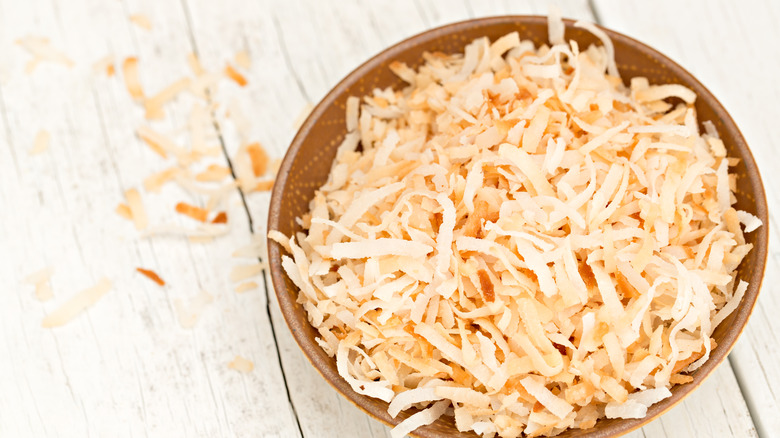You Can Toast Shredded Coconut In The Microwave (But With Caution)
Coconut can be a great topping for plenty of tropical-flavored desserts, like cakes, cookies, or on top of fruity ice creams. While you can buy pre-toasted coconut, it may be cheaper to crisp it up yourself — and you'll have the option of using fresh coconut, too.
When toasting coconut, you may be able to use your microwave for the fastest results. However, you'll need to keep a close eye on it to make sure it doesn't burn. Carefully spread your coconut around a microwave-safe dish, then start heating.
You'll want to pause the cooking to check on your coconut every half minute, taking the dish out and stirring the coconut around, ensuring that every piece gets heated thoroughly as it continues to cook. To achieve the perfect golden-brown color, your coconut will likely stay in the microwave for four to six minutes, depending on its wattage and your desired level of toasting.
Cooking in intervals is crucial
The most important part of toasting coconut in the microwave is to watch it carefully through the entire cooking process. Though it might seem a little tedious to keep checking on it, consistent stirring every 30 seconds will prevent your coconut from burning in the microwave. This will also make sure your coconut toasts more evenly — you don't want a burnt midsection with undercooked edges.
In fact, stirring your food as it heats in the microwave is beneficial no matter what you're cooking. Moving the toasted coconut around in the dish will cut out any cold spots that may not be heating evenly, allowing your food to cook more thoroughly.
Eventually, with a little extra attention, your coconut will wind up evenly toasted with a picture-perfect golden brown color. And, while you can also toast your coconut flakes in the oven or on the stovetop, the microwave might make things go a little faster.
Toasted coconut can go into a variety of sweet treats
Paying attention to your toasting technique is especially important when working with different kinds of coconut flakes. Unsweetened coconut generally has a little less moisture, and could heat up a little faster thanks to its dryness. Sweetened coconut flakes, however, have some added moisture and sugar that can caramelize alongside the coconut. Depending on which variety you choose to use, they could require different toasting times.
Once you've toasted your coconut, you can add it to a variety of dishes. The ingredient pairs well with chocolate and fruity flavors, and you can combine all three to whip up a delicious, creamy pie. If you're still craving something sweet, but you want something a little less chocolatey, try topping off a banana-flavored cake with a sprinkling of coconut. (And, of course, it is the star of the show when it comes to baking up a batch of coconut macaroons.)
The next time you need to make a batch of sweet coconut treats, save yourself some time and try microwaving your flakes.


